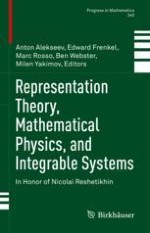Over the course of his distinguished career, Nicolai Reshetikhin has made a number of groundbreaking contributions in several fields, including representation theory, integrable systems, and topology. The chapters in this volume – compiled on the occasion of his 60th birthday – are written by distinguished mathematicians and physicists and pay tribute to his many significant and lasting achievements.
Covering the latest developments at the interface of noncommutative algebra, differential and algebraic geometry, and perspectives arising from physics, this volume explores topics such as the development of new and powerful knot invariants, new perspectives on enumerative geometry and string theory, and the introduction of cluster algebra and categorification techniques into a broad range of areas. Chapters will also cover novel applications of representation theory to random matrix theory, exactly solvable models in statistical mechanics, and integrable hierarchies. The recent progress in the mathematical and physicals aspects of deformation quantization and tensor categories is also addressed.
Representation Theory, Mathematical Physics, and Integrable Systems will be of interest to a wide audience of mathematicians interested in these areas and the connections between them, ranging from graduate students to junior, mid-career, and senior researchers.
